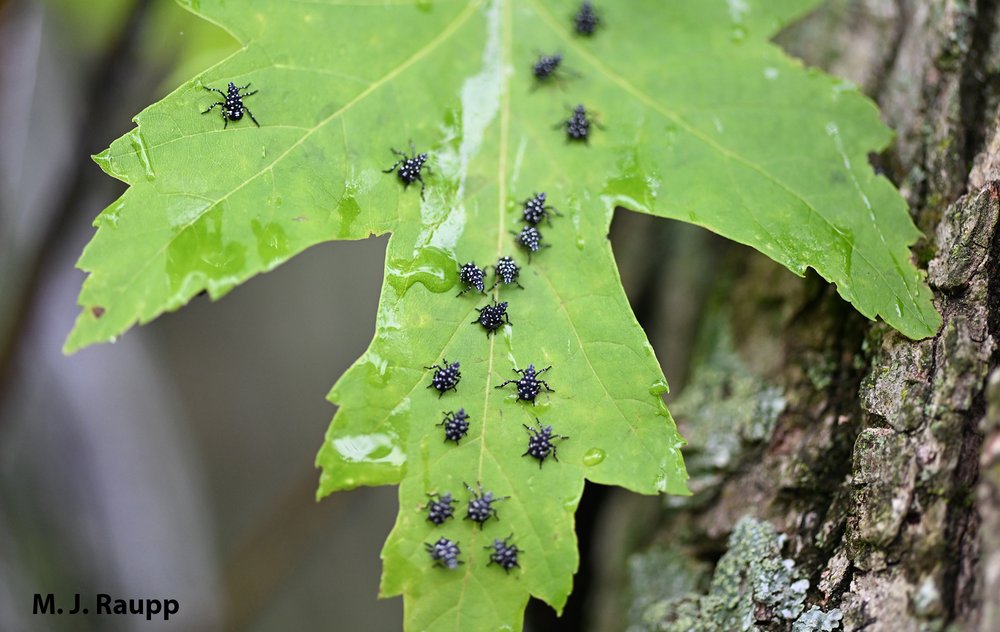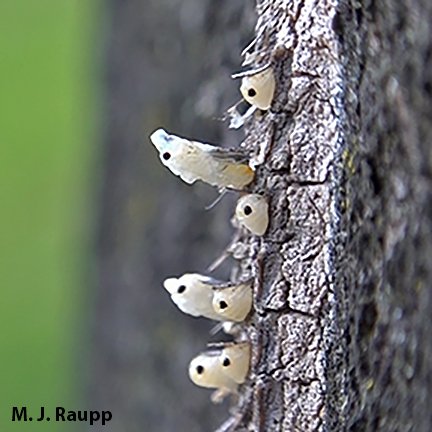From the mail bag – “Oh they’re back and they’re bad”: Spotted lanternfly nymphs, Lycorma delicatula

Spotted lanternfly nymphs are back, and they’re bad!
Last week I received a whimsical video from two avid young bug hunters who spotted spotted lanternfly nymphs in a park in Washington County, Maryland. Dressed in domino-colored exoskeletons of black and white, nymphs of spotted lanternflies are unmistakable. As these budding naturalists noted, they’re back and they’re bad. This season of lanternfly evil began about three weeks ago when lanternfly nymphs hatched from overwintering eggs deposited by their mothers last autumn.

Tiny, wraithlike spotted lanternfly nymphs pop the lid on their egg case and hatch head-first from eggs deposited last autumn.
Recently, I was asked when lanternflies would go away. Like other invasive species we’ve met, such as gypsy moths, brown marmorated stink bugs, emerald ash borers, and euonymus leaf-notchers just to name a few, the answer is this: they are not going away. At this time in Maryland, spotted lanternflies are established members of our ecosystems in all but four of our southernmost counties according to the Maryland Department of Agriculture. They have also established breeding populations in more than a dozen states and spread some 600 miles distant from their point of introduction in Berks County, Pennsylvania. The good news is that, in many locations, spotted lanternfly populations have declined dramatically. In parts of Pennsylvania, naturally occurring fungi put a beatdown on lanternfly populations. A recent study by scientists revealed that a vast number of established predators are helping to quell the lanternfly invasion. Arthropods led the reported carnage with more than 200 attacks by spiders, 196 attacks by mantids, 177 attacks by wasps, 55 attacks by sucking predators like assassin bugs, and another 21 attacks by other arthropods. Twenty some families of birds accounted for more than 500 attacks, with ground dwellers like chickens and pheasants leading the way. Death delivered by members of the cardinal, mocking bird, wren, and several other bird clans contributed to the total. Mammals, amphibians, fish and non-feathered reptiles also got into the act accounting for 106 additional observations.
Two budding naturalists have it right. Spotted lanternflies are back and they’re bad. Don’t be surprised to see dozens of spotted lanternfly nymphs feeding on small branches of trees and shrubs and stems of herbaceous plants. White spotted nymphs are scrambling up tree trunks. Leaves of maples and scores of other plants can be festooned with legions of lanternfly nymphs. Will predators and disease quell their mischief? Only time will tell.

Ravaging hordes of spotted lanternfly nymphs may be controlled by natural enemies, by simple mechanical means such as knocking them into soapy water, or by the use of OMRI approved pesticides.
Circling back to the lanternfly nymphs at the top of this episode, what should you do if you find these rascals on your plants? Well, you could just let them serve as a feast for the many predators and pathogens that will make a meal of them. Of course, if you are a viticulturalist, eliminating as many as possible is the order of the day and there are many highly efficacious insecticides to help do the job. But for homeowners, if you don’t want to wait for Mother Nature to intercede, you can knock them off your plants into a container of soapy water. They are not good swimmers. Or you can use one of several products such as insecticidal soaps, horticultural oils, or natural pyrethrins (not synthetic pyrethroids) listed for use on organic vegetables by the Organic Materials Review Institute (OMRI). Look for the OMRI symbol on the label of the insecticide. Excellent studies conducted by scientists at Penn State found these active ingredients provided excellent or good control of spotted lanternfly nymphs. Always read the label and follow instructions to the letter if you decide to go the insecticide route. Good luck dealing with these noisome pests from afar.
To learn more about the biology and management of spotted lanternfly, please click on this link: https://extension.psu.edu/spotted-lanternfly-management-guide
Acknowledgements
Penn State’s most excellent spotted lanternfly website was used to prepare this episode. Bug of the Week thanks Eloise and Abbigail for providing video footage and inspiration for this episode.
This post appeared first on Bug of the Week